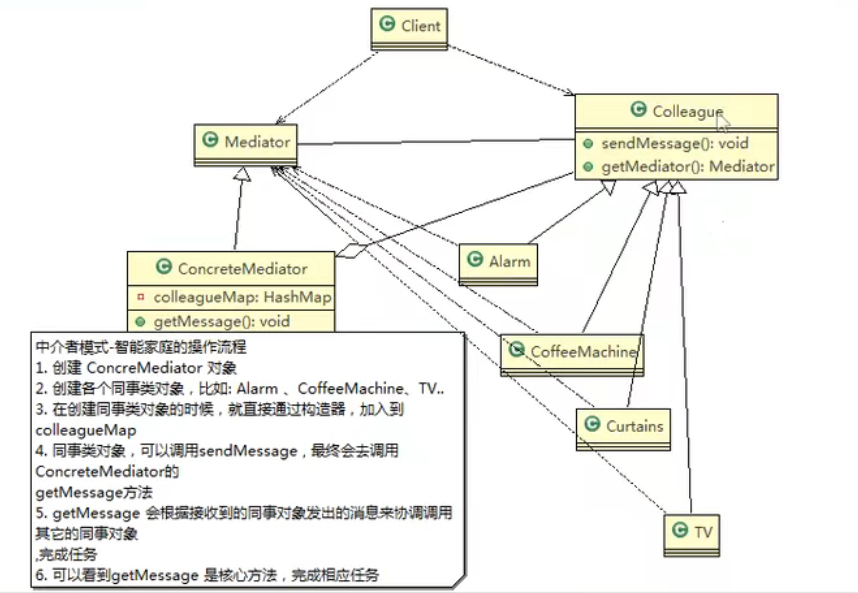中介者模式解决智能家电问题
-
方案类图

-
代码实现
package com.atguigu.mediator.smarthouse; //同事抽象类 public abstract class Colleague { private Mediator mediator; public String name; public Colleague(Mediator mediator, String name) { this.mediator = mediator; this.name = name; } public Mediator GetMediator() { return this.mediator; } public abstract void SendMessage(int stateChange); } package com.atguigu.mediator.smarthouse; //具体的同事类 public class Alarm extends Colleague { //构造器 public Alarm(Mediator mediator, String name) { super(mediator, name); //在创建Alarm 同事对象时,将自己放入到ConcreteMediator 对象中[集合] mediator.Register(name, this); } public void SendAlarm(int stateChange) { SendMessage(stateChange); } @Override public void SendMessage(int stateChange) { //调用的中介者对象的getMessage this.GetMediator().GetMessage(stateChange, this.name); } } package com.atguigu.mediator.smarthouse; public abstract class Mediator { //将给中介者对象,加入到集合中 public abstract void Register(String colleagueName, Colleague colleague); //接收消息, 具体的同事对象发出 public abstract void GetMessage(int stateChange, String colleagueName); public abstract void SendMessage(); } package com.atguigu.mediator.smarthouse; import java.util.HashMap; //具体的中介者类 public class ConcreteMediator extends Mediator { //集合,放入所有的同事对象 private HashMap<String, Colleague> colleagueMap; private HashMap<String, String> interMap; public ConcreteMediator() { colleagueMap = new HashMap<String, Colleague>(); interMap = new HashMap<String, String>(); } @Override public void Register(String colleagueName, Colleague colleague) { colleagueMap.put(colleagueName, colleague); if (colleague instanceof Alarm) { interMap.put("Alarm", colleagueName); } else if (colleague instanceof CoffeeMachine) { interMap.put("CoffeeMachine", colleagueName); } else if (colleague instanceof TV) { interMap.put("TV", colleagueName); } else if (colleague instanceof Curtains) { interMap.put("Curtains", colleagueName); } } //具体中介者的核心方法 //1. 根据得到消息,完成对应任务 //2. 中介者在这个方法,协调各个具体的同事对象,完成任务 @Override public void GetMessage(int stateChange, String colleagueName) { // TODO Auto-generated method stub //处理闹钟发出的消息 if (colleagueMap.get(colleagueName) instanceof Alarm) { if (stateChange == 0) { ((CoffeeMachine) (colleagueMap.get(interMap .get("CoffeeMachine")))).StartCoffee(); ((TV) (colleagueMap.get(interMap.get("TV")))).StartTv(); } else if (stateChange == 1) { ((TV) (colleagueMap.get(interMap.get("TV")))).StopTv(); } } else if (colleagueMap.get(colleagueName) instanceof CoffeeMachine) { ((Curtains) (colleagueMap.get(interMap.get("Curtains")))) .UpCurtains(); } else if (colleagueMap.get(colleagueName) instanceof TV) {//如果TV发现消息 } else if (colleagueMap.get(colleagueName) instanceof Curtains) { //如果是以窗帘发出的消息,这里处理... } } @Override public void SendMessage() { } } package com.atguigu.mediator.smarthouse; public class ClientTest { public static void main(String[] args) { //创建一个中介者对象 Mediator mediator = new ConcreteMediator(); //创建Alarm 并且加入到 ConcreteMediator 对象的HashMap Alarm alarm = new Alarm(mediator, "alarm"); //创建了CoffeeMachine 对象,并 且加入到 ConcreteMediator 对象的HashMap CoffeeMachine coffeeMachine = new CoffeeMachine(mediator, "coffeeMachine"); //创建 Curtains , 并 且加入到 ConcreteMediator 对象的HashMap Curtains curtains = new Curtains(mediator, "curtains"); TV tV = new TV(mediator, "TV"); //让闹钟发出消息 alarm.SendAlarm(0); coffeeMachine.FinishCoffee(); alarm.SendAlarm(1); } }
- 中介者模式的注意事项和细节
1) 多个类相互耦合,会形成网状结构, 使用中介者模式将网状结构分离为星型结构,进行解耦 2) 减少类间依赖,降低了耦合,符合迪米特原则 3) 中介者承担了较多的责任,一旦中介者出现了问题,整个系统就会受到影响 4) 如果设计不当,中介者对象本身变得过于复杂,这点在实际使用时,要特别注意


【推荐】国内首个AI IDE,深度理解中文开发场景,立即下载体验Trae
【推荐】编程新体验,更懂你的AI,立即体验豆包MarsCode编程助手
【推荐】抖音旗下AI助手豆包,你的智能百科全书,全免费不限次数
【推荐】轻量又高性能的 SSH 工具 IShell:AI 加持,快人一步
· DeepSeek 开源周回顾「GitHub 热点速览」
· 物流快递公司核心技术能力-地址解析分单基础技术分享
· .NET 10首个预览版发布:重大改进与新特性概览!
· AI与.NET技术实操系列(二):开始使用ML.NET
· 单线程的Redis速度为什么快?